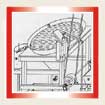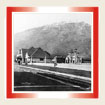|
1 | Page 2
 Clark continued with his research, and in the early
1930s he discovered what the role of the reagent was
in separation. At this time, Clark was working with
sand coming from a quarry to the north of the
previous quarries with which he had worked. He
noticed the sands from this location were not
separating the way he expected them to. Clark continued with his research, and in the early
1930s he discovered what the role of the reagent was
in separation. At this time, Clark was working with
sand coming from a quarry to the north of the
previous quarries with which he had worked. He
noticed the sands from this location were not
separating the way he expected them to.
It turned out the sands from this quarry were
different from those mined from others in that there
was a considerable amount of soluble salts present
in them. This caused a high level of acidity, which
was causing the difficulty in separation. To
separate them, the sands had to be neutralized by an
alkaline substance, such as soap reagent.
Clark further discovered that certain neutralizing
agents worked better than others. While lime and
caustic soda did not work well, soda ash worked
perfectly. In his 1931 report to the Alberta
Research Council, Clark states, “generally speaking,
if bituminous sand as found in Northern Alberta is
mixed and heated with a solution of soda ash till
all its acidity is neutralized and then washed in
hot water, practically one hundred percent of the
bitumen content of the same will be recovered.”
 Clark continued his research, and was granted one
more patent in 1948. The patented process improved
upon previous separation techniques by identifying
the role of air bubbles in separation. Air bubbles
occur naturally in the oilsands and are necessary
for the separation of the bitumen. Bitumen particles
attach to the air bubbles and float to the surface. Clark continued his research, and was granted one
more patent in 1948. The patented process improved
upon previous separation techniques by identifying
the role of air bubbles in separation. Air bubbles
occur naturally in the oilsands and are necessary
for the separation of the bitumen. Bitumen particles
attach to the air bubbles and float to the surface.
If there is too much air, however, sand will start
attaching to the oil bubbles, causing excessive sand
to be present with the bitumen. The patent makes it
clear that the amount of air used must be controlled
in order for the process to work efficiently. Though
Clark discovered this principle over fifty years ago,
it is still employed today.
 |
Washing Out the Sand
The problem of separating bitumen from the oil sands was one approached by several innovative minds, from G. Christian Hoffman to Dr. Karl Adolf Clark. In this excerpt from the JuneWarren publication, The Great Canadian Oil Patch: The Petroleum Era from Birth to Peak, author Earle Gray describes some of the scientific efforts made to solve the mystery of separating bituminous sands. Read more… |
|
 Heritage Community Foundation Presents
Heritage Community Foundation Presents


 Heritage Community Foundation Presents
Heritage Community Foundation Presents